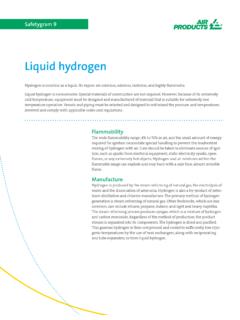Transcription of RADIOPHARMACEUTICALS - World Health Organization
1 Document November 2008 RADIOPHARMACEUTICALS Final text for addition to T he International Pharm acopoeia (November 2008) This text was adopted at the Forty-third WHO Expert Committee on Specifications for Pharmaceutical Preparations in October 2008 for addition to the 4th edition of The International Pharmacopoeia. Contents Introduction Monographs General monograph Specific monographs Methods of Analysis Supplementary Information Introduction RADIOPHARMACEUTICALS are unique medicinal formulations containing radioisotopes which are used in major clinical areas for diagnosis and/or therapy.
2 The facilities and procedures for the production, use, and storage of RADIOPHARMACEUTICALS are subject to licensing by national and/or regional authorities. This licensing includes compliance both with regulations governing pharmaceutical preparations and with those governing radioactive materials. Additional regulations may apply for issues such as transportation or dispensing of RADIOPHARMACEUTICALS . Each producer or user must be thoroughly cognizant of the national requirements pertaining to the articles concerned.
3 Regulations concerning pharmaceutical preparations include the application of current Good Manufacturing Practices (GMP). Guidelines are available in Quality assurance of pharmaceuticals, Volume 2: Good manufacturing Document page 2 practices and inspection (WHO, Geneva, 2004); for the current WHO recommendations consult the WHO Medicines web site ( ). Regulations governing radioactive materials include those on safe handling and production of radioisotopes. See International Basic Safety Standards for Protection against Ionizing Radiation and for the Safety of Radiation Sources (IAEA, Vienna, 2003, CD-ROM Edition) Safety Series No.
4 115/CD and Radiological Protection for Medical Exposure to Ionizing Radiation Safety Guide (IAEA, Vienna, 2002) Safety Standard Series No. Consult the IAEA website for the current Safety Standards and publications ( ). **new page** RADIOPHARMACEUTICALS This general monograph is intended to be read in conjunction with the individual monographs on radiopharmaceutical preparations. A radiopharmaceutical preparation that is subject of an individual monograph in The International Pharmacopoeia complies with the general requirements stated below and with the general monograph for the relevant dosage form (most commonly that for Parenteral preparations) as modified by any of the requirements given below and by any specific instruction included in the individual monograph.
5 Additional information See Annex for terminology applied to RADIOPHARMACEUTICALS Shelf-life The shelf-life (expiry period) of a radiopharmaceutical preparation depends primarily on the physical half-life of the radioisotope, the radiochemical stability and the content of longer-lived radionuclidic impurities in the preparation under consideration. Many radiopharmaceutical preparations contain radioisotopes with very short half-lives and such preparations therefore have very short shelf-lives. Such preparations require an expiry date and time to be indicated.
6 For example, technetium based preparations and positron emission tomography (PET) preparations are normally intended to be used within less than12 hours (some within minutes) of preparation. At the end of the expiry period, the radioactivity will have decreased to the extent where insufficient radioactivity remains to serve the intended purpose or where the dose of active ingredient must be increased so much that undesirable physiological responses occur. In addition, chemical or radiation decomposition may have reduced the radiochemical purity to an unacceptable extent.
7 In addition the radionuclidic impurity Document page 3 content may be such that an unacceptable radiation dose would be delivered to the patient. The shelf-life of a multidose radiopharmaceutical preparation, after aseptic withdrawal of the first dose, will also depend on microbiological considerations. For radiopharmaceutical preparations containing radioisotopes with long half-lives, microbiological considerations may take precedence over those based on the physical half-life of the radioisotope. For example, once the first dose has been aseptically withdrawn from a multidose container of a iodine-containing injection, the container should be stored at a temperature between 2 and 8 C and the contents used within 7 days.
8 Definition RADIOPHARMACEUTICALS can be divided into four categories: Radiopharmaceutical preparation A radiopharmaceutical preparation is a medicinal product in a ready-to-use form suitable for human use that contains a radionuclide. The radionuclide is integral to the medicinal application of the preparation, making it appropriate for one or more diagnostic or therapeutic applications. Radionuclide generator A system in which a daughter radionuclide (short half-life) is separated by elution or by other means from a parent radionuclide (long half-life) and later used for production of a radiopharmaceutical preparation.
9 Radiopharmaceutical precursor A radionuclide produced for the radiolabelling process with a resultant radiopharmaceutical preparation. Kit for radiopharmaceutical preparation In general a vial containing the non-radionuclide components of a radiopharmaceutical preparation , usually in the form of a sterilized, validated product to which the appropriate radionuclide is added or in which the appropriate radionuclide is diluted before medical use. In most cases the kit is a multidose vial and production of the radiopharmaceutical preparation may require additional steps such as boiling, heating, filtration and buffering.
10 Radiopharmaceutical preparations derived from kits are normally intended for use within 12 hours of preparation. Manufacture The manufacturing process for radiopharmaceutical preparations should meet the requirements of Good Manufacturing Practice. The manufacturer is responsible for ensuring the quality of his products, and especially for examining preparations of short-lived radionuclides for long-lived impurities after a suitable period of decay. In this way, the manufacturer ensures that the manufacturing processes employed are producing materials of appropriate quality.













